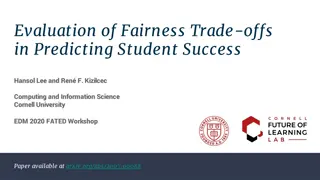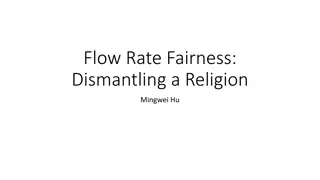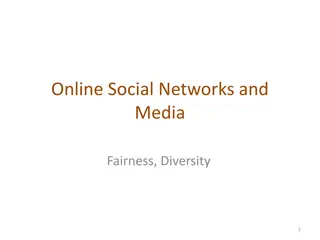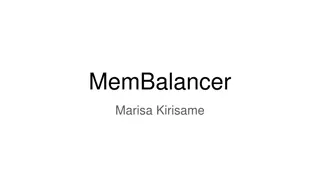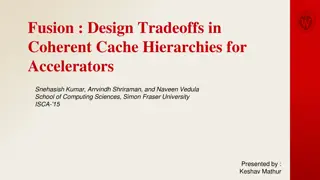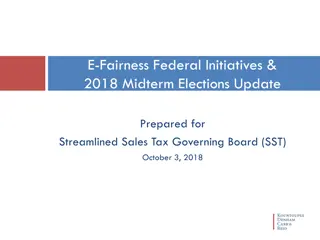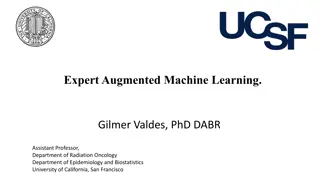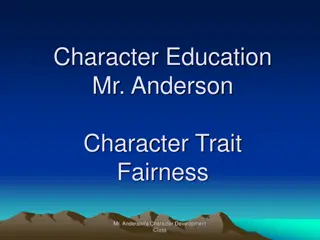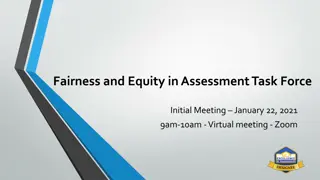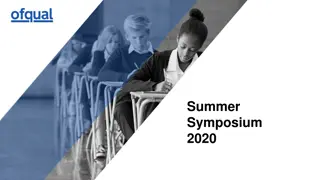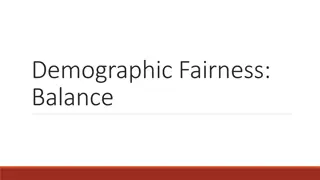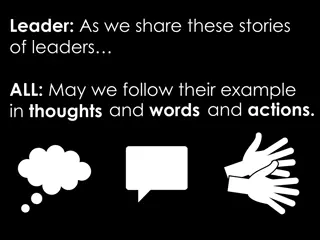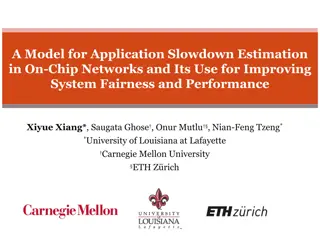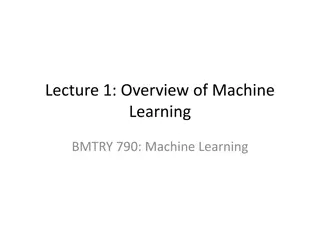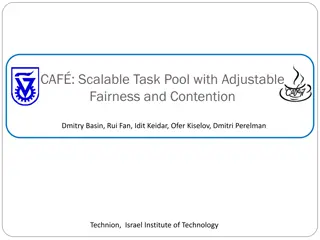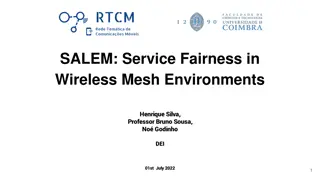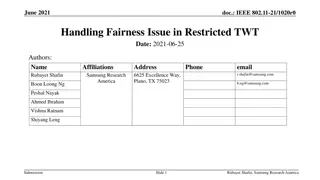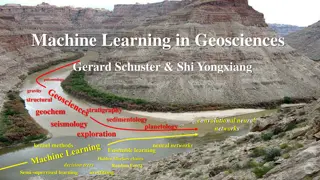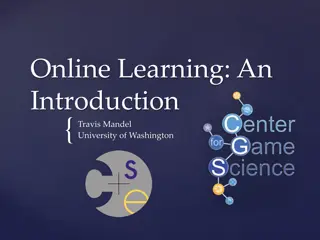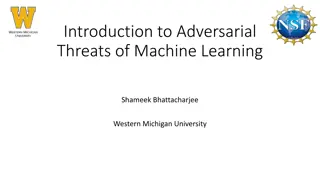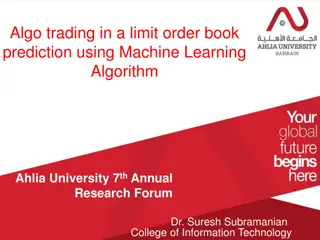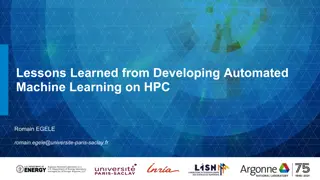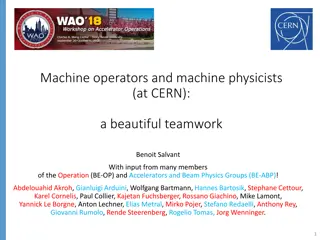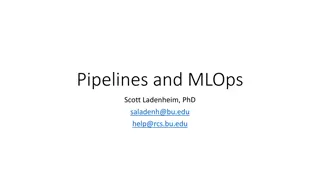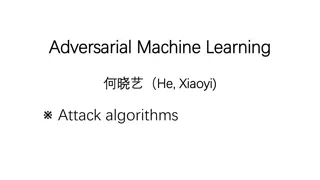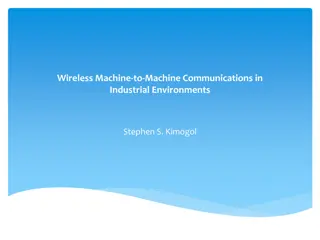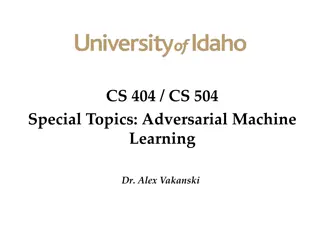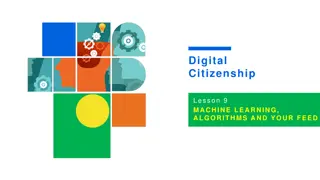Understanding Fairness and Tradeoffs in Machine Learning
Explore the concept of fairness in machine learning models and how biases can impact decision-making processes. Delve into various sources of bias and frameworks for understanding unintended consequences. Using college admissions as an example, discover different approaches to achieving group fairness in algorithmic decision-making. Learn about the challenges in achieving fairness in real-world ML models and the tradeoffs involved in meeting multiple fairness conditions simultaneously.
Download Presentation

Please find below an Image/Link to download the presentation.
The content on the website is provided AS IS for your information and personal use only. It may not be sold, licensed, or shared on other websites without obtaining consent from the author. Download presentation by click this link. If you encounter any issues during the download, it is possible that the publisher has removed the file from their server.
E N D
Presentation Transcript
CSE/STAT 416 Fairness and Tradeoffs Hunter Schafer Paul G. Allen School of Computer Science & Engineering University of Washington April 21, 2021
Discussion heavily based on Suresh and Guttag (2020) Sources of Bias Six common sources of bias: Historical bias Representation Bias Measurement Bias Aggregation Bias Evaluation Bias Deployment Bias A FRAMEWORK FOR UNDERSTANDING UNINTENDED CONSEQUENCES OF MACHINE LEARNING, BY HARINI SURESH AND JOHN V. GUTTAG, 2020 2
Fairness What does it mean for a model to be fair or unfair? Can we come up with a numeric way of measuring fairness? Lots of work in the field of ML and fairness is looking into mathematical definitions of fairness to help us spot when something might be unfair. There is not going to be one central definition of fairness, as each definition is a mathematical statement of which behaviors are/aren t allowed. Different definitions of fairness can be contradictory! 3
Example: College Admissions Will use a very simplified example of college admissions. This is not an endorsement of such a system or a statement of how we think the world does/should work. Will make MANY simplifying assumptions (which are unrealistic). There is a single definition of success for college applicants, and the goal of an admissions decision is to predict success The only thing we will use as part of our decision is SAT Score To talk about group fairness, will assume everyone belongs to exactly one of two races: Circles (66%) or Squares (33%). 4
Group Fairness Fairness through Unawareness Statistical Parity - Require admissions match demographics in data Equal Opportunity - Require false-negative rate to be equal across groups Predictive Equality - Require false-positive rate to be equal across groups 5
(Im)possibility of Fairness Four reasonable conditions we want in a real world ML Model: 1. Statistical Parity 2. Equal Opportunity (Equality across false negative rates) 3. Predictive Equality (Equality across false positive rates) 4. Good accuracy of the model across subgroups In general, can t satisfy all 4 simultaneously unless groups have the exact same underlying distribution. This condition is rarely met in practice as we mentioned earlier when there are so many places for bias to enter our data collection. 6
College Admissions - Continued Continuing overly simplistic college admissions example, with a fake dataset. Majority (2/3) are Circle, the remaining 1/3 are Square SAT score for Circles tends to be inflated when compared to Squares. Possibility: Systematic barriers and access to SAT Prep Even though we see statistical differences between groups in our data, the rate in which they are actually successful is the same. 7
Accuracy and Fairness With only one feature, we will consider a simple threshold classifier (a linear classifier with 1 input!). The most accurate model is not necessarily the most fair. 8
Fairness- Accuracy Tradeoff In general, we find there is a tradeoff between accurate models and fair models. Making a model more fair tends to decrease accuracy by some amount. 9
Notes on Tradeoff Might argue that my example is overly simplistic (it is!), but I ll claim this is a proof of concept. We saw lots of examples of accurate models that were unfair. This is not a statement that a tradeoff necessarily must exist, it just generally happens in real-world datasets. Originally just cared about finding the most accurate model, saw unfairness as a byproduct. Controlling for fairness will yield a different model than you found before. If we recognize data can encode biases and accuracy is determined in terms of that data, trying to achieve fairness will likely hurt accuracy. - In the example before, the artificial difference in SAT scores caused the problem. 10
Visualizing the tradeoff between fairness and accuracy Does not tell you which tradeoff is appropriate! Pareto Frontier 11
This feels a bit cold-hearted, its okay to like this is weird. Michael Kearns and Aaron Roth write in The Ethical Algorithm Thoughts on Pareto Frontier While the idea of considering cold, quantitative trade-offs between accuracy and fairness might make you uncomfortable, the point is that there is simply no escaping the Pareto frontier. Machine learning engineers and policymakers alike can be ignorant of it or refuse to look at it. But once we pick a decision-making model (which might in fact be a human decision-maker), there are only two possibilities. Either that model is not on the Pareto frontier, in which case it s a bad model (since it could be improved in at least one measure without harm in the other), or it is on the frontier, in which case it implicitly commits to a numerical weighting of the relative importance of error and unfairness. Thinking about fairness in less quantitative ways does nothing to change these realities it only obscures them. Making the trade-off between accuracy and fairness quantitative does not remove the importance of human judgment, policy, and ethics it simply focuses them where they are most crucial and useful, which is in deciding exactly which model on the Pareto frontier is best (in addition to choosing the notion of fairness in the first place, and which group or groups merit protection under it, [ ]). Such decisions should be informed by many factors that cannot be made quantitative, including what the societal goal of protecting a particular group is and what is at stake. Most of us would agree that while both racial bias in the ads users are shown online and racial bias in lending decisions are undesirable, the potential harms to individuals in the latter far exceed those in the former. So in choosing a point on the Pareto frontier for a lending algorithm, we might prefer to err strongly on the side of fairness for example, insisting that the false rejection rate across different racial groups be very nearly equal, even at the cost of reducing bank profits. We ll make more mistakes this way both false rejections of creditworthy applicants and loans granted to parties who will default but those mistakes will not be disproportionately concentrated in any one racial group. 12
Brain Break Brain Break Brain Break 13
Fairness as Worldview 14
Context So far have discussed notions of group fairness, but other notions of fairness exist. Provide a framework for how to approach learning tasks and what assumptions we make. Based on Friedler et al. (2016). High level ideas: Data gathering and modeling Individual fairness vs. group fairness Common world-views that dictate which fairness is appropriate How these worldviews can contradict each other 15
ML and Spaces Defined modeling as transformation through three spaces Construct space: True quantities of interest (unobserved) Observed space: Data gathered to (hopefully) represent constructs. Achieved through measurement of proxies. Decision space: The decisions of the model. Models take observed data and make decisions. 16
Individual Fairness Idea: If two people are close in construct space, they should receive similar decisions. Individual Fairness: A model ?:?? ?? is said to be fair if objects close in CS are close in DS. Specifically, it is ?,? -fair if for any ?,? ?? ????,? ? ???? ? ,? ? ? 17
Worldview 1: WYSIWYG Problem: We can t tell if two objects are close in CS. So if we want to use individual fairness, we must make an assumption about how the world workds What You See is What You Get (WYSIWYG): The Observed Space is a good representation of the Construct Space. Example: For college admissions, things like SAT correlate well with intelligence. With WYSIWYG, you can ensure fairness by comparing objects in the Observed Space as a good proxy for the Construct Space 18
Worldview 2: Structural Bias + WAE What if we don t believe the Observed Space represents the Construct Space well? What if there is some structural bias that make people close in the construct space look different in the observed space? Example: SAT doesn t just measure intelligence, but also measures ability to afford SAT prep. People who are just as intelligent as someone else, can end up with different observations. 19
Worldview 2: Structural Bias + WAE When considering Structural Bias, commonly will also assume We re All Equal (WAE). We re All Equal (WAE): Membership in some protected group (e.g., race) should not be the cause of a meaningful difference for the task at hand (e.g., academic preparation). Not saying every group is exactly equal in all ways, but for the task at hand we are equal enough that it shouldn t be the cause of difference. Differences seen in groups in Observed Space are the result of structural bias! Notions of group fairness make sense with Structural Bias + WAE 20
Which One? So which is right? WYSIWYG or Structural Bias + WAE? No way to know! They are statements of belief! Which worldview you use determines what you think is fair If you assume WYSIWYG Individual fairness is right and easy to achieve Non-discrimination may violate individual fairness If you assume Structural Bias + WAE Non-discrimination is right and is possible (saw group fairness mechanisms) Attempts to achieve individual fairness may result in discrimination. 21
Takeaways Models can have a huge impact on society, both positive and negative. - If we are not careful, our models will at best, perpetuate and at worst, amplify injustice in our society. Historically, people thought defining things like accuracy was easy but defining what is/isn t fair was not. Only recently (~10 years) have ML researchers tried to define what fairness might mean and how to enforce it in our models. It s clear that defining and enforcing fairness, but what fairness and how is a crucial problem we need humans (and not just ML engineers) in the loop to determine. These are questions of values, and we need humans to make informed decisions of what is right. 22
Recap Theme: Thinking about fairness and the limitations of learning as a worldview. Concepts: Impossibility to achieve all fairness and accuracy Fairness-accuracy tradeoff Pareto Frontier Modeling Spaces - Construct space - Observed space - Decision space Individual fairness What You See is What You Get (WYSIWYG) Structural Bias + We re All Equal (WAE) Conflicting Worldviews 23
Brain Break Brain Break Brain Break 24
Regression Overfitting Training, test, and generalization error Bias-Variance tradeoff Ridge, LASSO Cross validation Gradient descent Classification Logistic regression Bias and Fairness One Slide 25
Case Study 1: Predicting house prices ML Regression Intelligence Data Method $ = ?? price ($) $ $ $ + house features house size 26 STAT/CSE 416: Intro to Machine Learning
y Regression Case study: Predicting house prices price ($) x Linear regression Regularization: Ridge (L2), Lasso (L1) house size Models y price ($) x[2] # bath Including many features: - Square feet - # bathrooms - # bedrooms - Lot size - Year built - x[1] house size bedrooms bathrooms sqft_living sqft_lot floors yr_built yr_renovat waterfront 2 RSS(w) + ||w||2 200000 coefficients j 100000 0 100000 0 50000 100000 150000 200000 27 STAT/CSE 416: Intro to Machine Learning
Regression Case study: Predicting house prices Algorithms Gradient descent RSS(w0,w1) = ($house 1-[w0+w1sq.ft.house 1])2 + ($house 2-[w0+w1sq.ft.house 2])2+ ($house 3-[w0+w1sq.ft.house 3])2+ [include all houses] 28 STAT/CSE 416: Intro to Machine Learning
Regression Case study: Predicting house prices Validation set Test set Training set fit test performance of to select * Loss functions, bias-variance tradeoff, cross-validation, sparsity, overfitting, model selection Concepts assess generaliza on error of * fw(true) Error y 1. Noise price ($) OVERFIT 2. Bias fw x square feet (sq.ft.) 3. Variance y price ($) y y Model complexity x square feet (sq.ft.) x x 29 STAT/CSE 416: Intro to Machine Learning
Case Study 2: Sentiment analysis ML Classification Intelligence Data Method Sushi was awesome, the food was awesome, but the service was awful. Score(x) < 0 All reviews: awful Score(x) > 0 awesome 30 STAT/CSE 416: Intro to Machine Learning
Classification Case study: Analyzing sentiment Start excellent poor Credit? fair Income? Term? Safe high Low 3 years 5 years Linear classifiers (logis c regression) Mul class classifiers Decision trees Boosted decision trees and random forests Term? Safe Risky Risky Models 3 years 5 years Safe Risky #awful Score(x) < 0 1.0 #awesome 1.5 #awful = 0 4 3 2 1 Score(x) > 0 0 0 1 2 3 4 #awesome 31 STAT/CSE 416: Intro to Machine Learning
Classification Case study: Analyzing sentiment Decision boundaries, maximum likelihood estimation, ensemble methods, random forests Precision and recall Concepts Classifier A Best classifier Classifier B (w0,w1,w2) 1 precision 0 recall 1 32 STAT/CSE 416: Intro to Machine Learning



